Pioneers of art
Source: China Daily | 2022-02-25 | Editor:Irene

A paper-cut by folk artist Chen Jing highlights the unity of people from different ethnic groups in the Xinjiang Uygur autonomous region. (China Daily)
An ongoing online exhibition featuring 200 paintings, woodcut prints, paper-cut pieces and copperplate etchings allows viewers to see, as if through the eyes of the artist, the natural wonders and folk customs of Northwest China's Xinjiang Uygur autonomous region.
It is worth mentioning that the exhibits are created exclusively by artists aged 70 or above, with the oldest being a sprightly 94.
This group are the witnesses of how art thrives in Xinjiang. Their works, which keep abreast of the times, pay homage to labor heroes and chronicle the everyday lives of Xinjiang dwellers from different ethnic groups. The works display a truthfulness that bears an important academic value, allowing the study of the development trajectory of the region's arts sector, according to the editor's notes on the online exhibition.
After the People's Republic of China was founded in 1949, groups of young enthusiasts, including scholars, soldiers and technicians from other cities and provinces traveled to the country's far west, throwing themselves into developing Xinjiang.
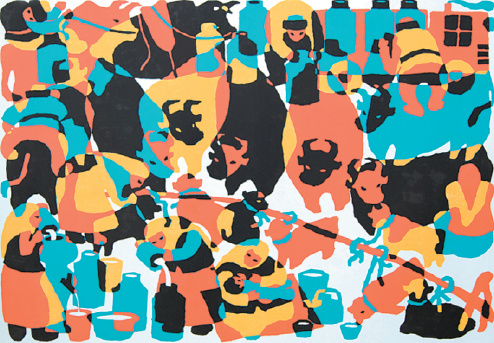
Artworks themed on Xinjiang's natural beauty and scenes of people's daily life are showcased in an online exhibition. (China Daily)
The artists are among the pioneers who opened up the vast land of Xinjiang.
And the artworks they've created approach how the region has changed over the decades from various perspectives, says Chen Jing, the online exhibition's chief editor and also the deputy director of the institute of natural and cultural heritage research at Nanjing University.
Chen also has some of his traditional Chinese paintings and paper-cut works displayed at the exhibition.
The 82-year-old artist once spent around three decades living and working in Xinjiang.
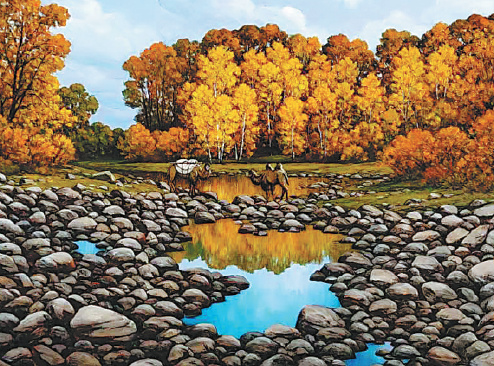
Artworks themed on Xinjiang's natural beauty and scenes of people's daily life are showcased in an online exhibition. (China Daily)
In his view, it's in his hometown, Taizhou, a historical city in South China's Jiangsu province, that he became enthusiastic about folk art and in his second home, Xinjiang, he refined his artwork thanks to the region's blended cultures.
Chen was imbued from a young age with a variety of folk arts, growing up amid a rich atmosphere of traditional culture. Family members were equipped with the skills of making folk handicrafts, such as clay sculptures and colorful lanterns.
When traditional festivals came around, temple fairs and other folk activities, in which visitors were surrounded by a wide array of folk-art practices and works, would spring up everywhere, particularly in historical sites scattered around Taizhou, Chen recalls.
"Consequently, I became an aficionado of folk arts," he says.
He learned drawing and paper-cutting and started to publish his works in local newspapers during his school years.
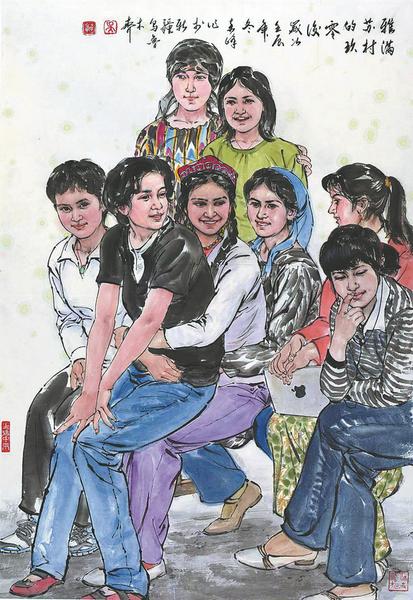
Artworks themed on Xinjiang's natural beauty and scenes of people's daily life are showcased in an online exhibition. (China Daily)
After graduating from university in 1963, he volunteered to support the development of Xinjiang where he successively became a high school teacher, a civil servant, a magazine designer and a leader in the local literary and art federation.
No matter which post he attained, Chen never gave up creating art.
"Initially, I lived in a flat covering around a dozen square meters with my wife and eldest son," Chen says as he recalls his time in Xinjiang.
There was just one desk in the flat, which my son used to do his homework on. Chen had to kneel on the ground to use the bed as a worktable.
Although suffering from shortage of materials and difficult circumstances, he still managed to create a series of paper-cuts.
"I often worked late into the night. I felt happy though," he says.
In 1980, he initiated a paper-cut research association in Xinjiang to better foster the folk art's evolution in the region.
He believes that Xinjiang is among the most culturally diverse regions in China.
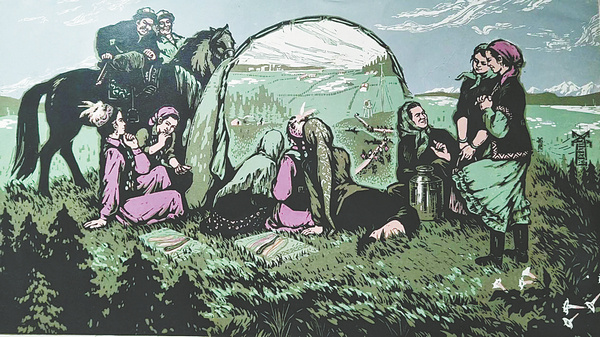
Artworks themed on Xinjiang's natural beauty and scenes of people's daily life are showcased in an online exhibition. (China Daily)
Communicating with people in Xinjiang's literary and art circles, from different cultural backgrounds, can nurture his artistic creations. Meanwhile, the unity of various ethnic groups helps to inspire his patriotism.
Chen returned to his native Jiangsu in the 1990s.
"After my retirement, I still miss Xinjiang and the friends I once worked with there," Chen says.
Chen and his colleagues set up a group chat on social media platform WeChat, in which they often reminisce about the past, catch up on all the news and conduct discussions about art.
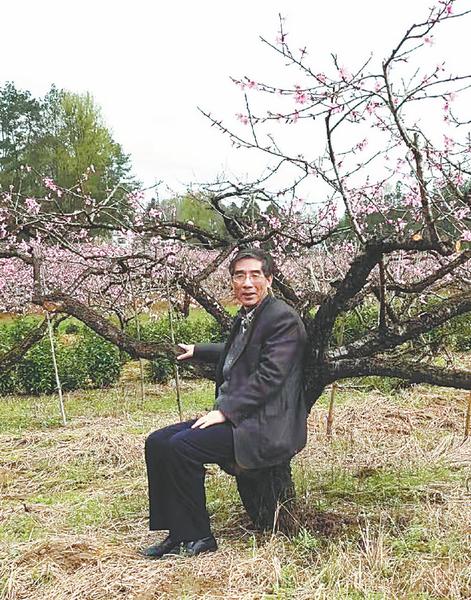
Chen Jing. (China Daily)
"We found that many artists from the first generation of pioneers in Xinjiang have already passed away. It's a matter of urgency to collect the creations of those left as part of Xinjiang's art history," Chen says.
Chen and other editors started to get in touch with elderly artists who once worked or are still living in Xinjiang to collect photos of their paintings, woodcut pictures and paper-cut works for the online exhibition.
"We hope that these artworks can help people from home and abroad learn more about the realities of Xinjiang and have some insight into how it came to achieve the prosperity of today," he adds.
You May Like
-
Wang Yuhui expresses the beauty of Yunnan’s biodiversity in...
With the theme of “The code of life in heavy color painting; Thousands of leaves and sound” , Wang Yuhui’s painting exhibition took place at Elephament art g...
InKunming 2021-12-20 -
Chinese-made games regale global gamers with cultural feast
Dressed like a female warrior in Beijing Opera, a newly-unveiled character in the Chinese-made game Genshin Impact, has stirred the fervor of gamers globally.
InKunming 2022-01-12 -
Prehistoric relics unearthed in China's Hunan
Archaeologists have recently discovered new potteries and stone artifacts from a site dating back between 3,800 to 4,200 years in central China's Hunan Province...
InKunming 2022-01-12 -
Chinese drama Song of Glory wins global glory at Emmy
Chinese costume drama Song of Glory recently won the best telenovela award at the 49th International Emmy Awards.
InKunming 2021-12-28 -
China's 'lion dance' animation comedy lauded despite tepid e...
Despite moderate box office gains since its opening on Dec 17, Chinese animation comedy "I Am What I Am" continues to grab headlines and receive wide applause.
InKunming 2021-12-28 -
New archaeological discoveries unravel mystery of ancient Ya...
Chinese archaeologists have recently unearthed a significant number of artifacts dating back to the Western Zhou Dynasty (1046-771 B.C.) at a relic site in Beij...
InKunming 2021-12-27 -
Flood-destroyed ancient bridge to reopen in east China
A 480-year-old bridge destroyed by floods in east China's Anhui Province will reopen soon after over a month of repair, local authorities said.
InKunming 2021-12-27 -
City history museum opens in NE China
A museum featuring the regional history and culture of Shenyang, capital of northeast China's Liaoning Province, opened to the public on Tuesday, according to l...
InKunming 2021-12-27 -
Archaeologists unearth evidence of cultural exchange 5,000 y...
Archaeologists conducting excavations at the Suyang relics site in Henan Province, central China, have found evidence of exchanges between different cultures in...
InKunming 2021-12-27 -
Tombs in Eastern Han Dynasty found in Qujing
On Dec 20, archaeologists of the Institute of Archaeology, Chinese Academy of Social Sciences, and others from Yunnan, Guizhou, and Guangxi gathered at the exca...
InKunming 2021-12-22







